David Game College: Business and Business Environment Analysis Report
VerifiedAdded on 2020/10/04
|13
|4363
|299
Report
AI Summary
This report delves into the correlation between business and its environment, emphasizing the importance of a suitable environment for business growth. It explores various organizational types, including public, private, and non-profit sectors, highlighting their structures and objectives. The report uses examples such as Tesco (public), H&M (private), and International Children's Care UK (non-profit) to illustrate their operations, legal structures, and financial performance. Furthermore, it analyzes the impact of macro-environmental factors using PESTLE analysis and assesses the internal strengths and weaknesses of the chosen organizations through SWOT analysis. The report concludes with an integrated analysis of these findings and their influence on decision-making within organizations. It also includes an organizational chart of Tesco to illustrate its hierarchical structure.
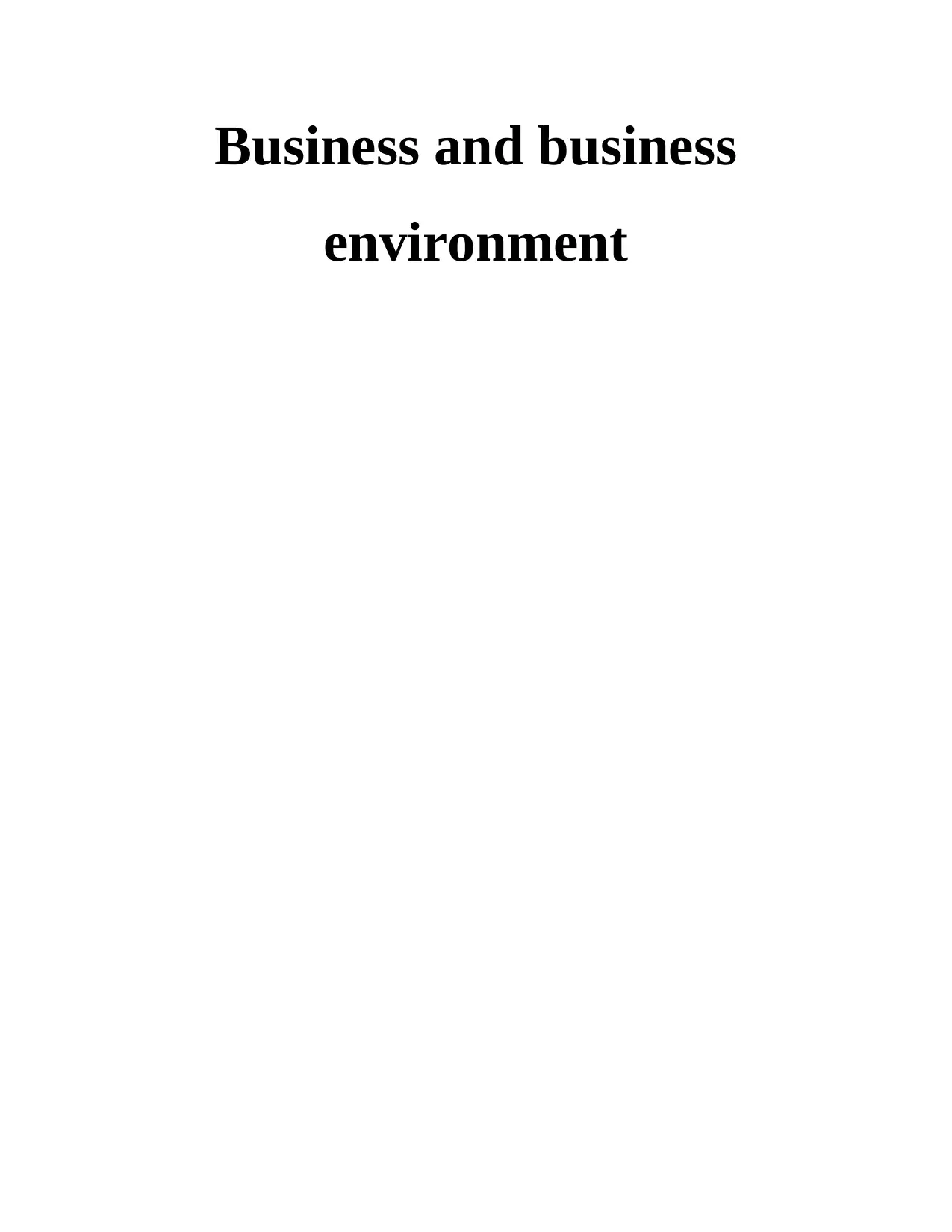
Business and business
environment
environment
Paraphrase This Document
Need a fresh take? Get an instant paraphrase of this document with our AI Paraphraser
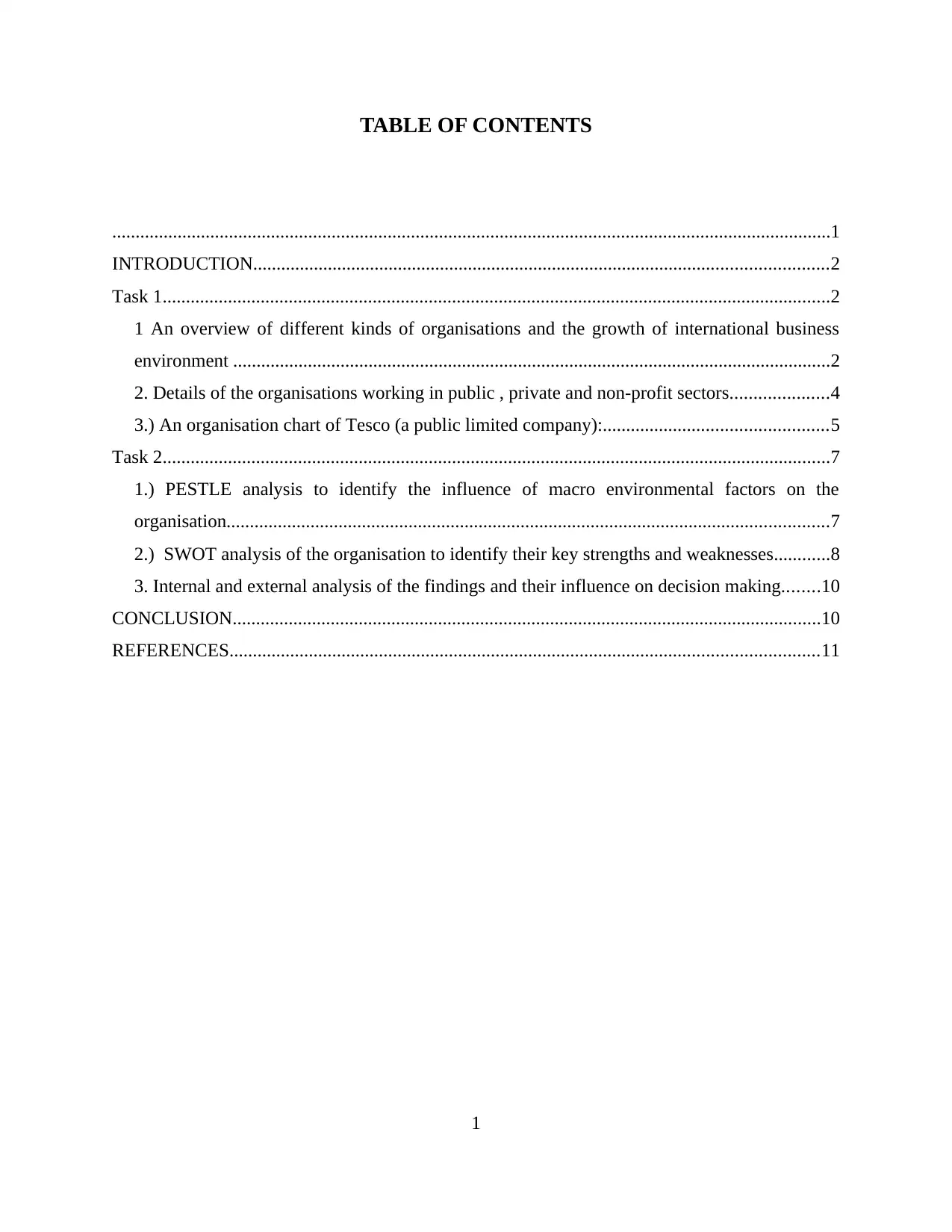
TABLE OF CONTENTS
..........................................................................................................................................................1
INTRODUCTION...........................................................................................................................2
Task 1...............................................................................................................................................2
1 An overview of different kinds of organisations and the growth of international business
environment ................................................................................................................................2
2. Details of the organisations working in public , private and non-profit sectors.....................4
3.) An organisation chart of Tesco (a public limited company):................................................5
Task 2...............................................................................................................................................7
1.) PESTLE analysis to identify the influence of macro environmental factors on the
organisation.................................................................................................................................7
2.) SWOT analysis of the organisation to identify their key strengths and weaknesses............8
3. Internal and external analysis of the findings and their influence on decision making........10
CONCLUSION..............................................................................................................................10
REFERENCES..............................................................................................................................11
1
..........................................................................................................................................................1
INTRODUCTION...........................................................................................................................2
Task 1...............................................................................................................................................2
1 An overview of different kinds of organisations and the growth of international business
environment ................................................................................................................................2
2. Details of the organisations working in public , private and non-profit sectors.....................4
3.) An organisation chart of Tesco (a public limited company):................................................5
Task 2...............................................................................................................................................7
1.) PESTLE analysis to identify the influence of macro environmental factors on the
organisation.................................................................................................................................7
2.) SWOT analysis of the organisation to identify their key strengths and weaknesses............8
3. Internal and external analysis of the findings and their influence on decision making........10
CONCLUSION..............................................................................................................................10
REFERENCES..............................................................................................................................11
1
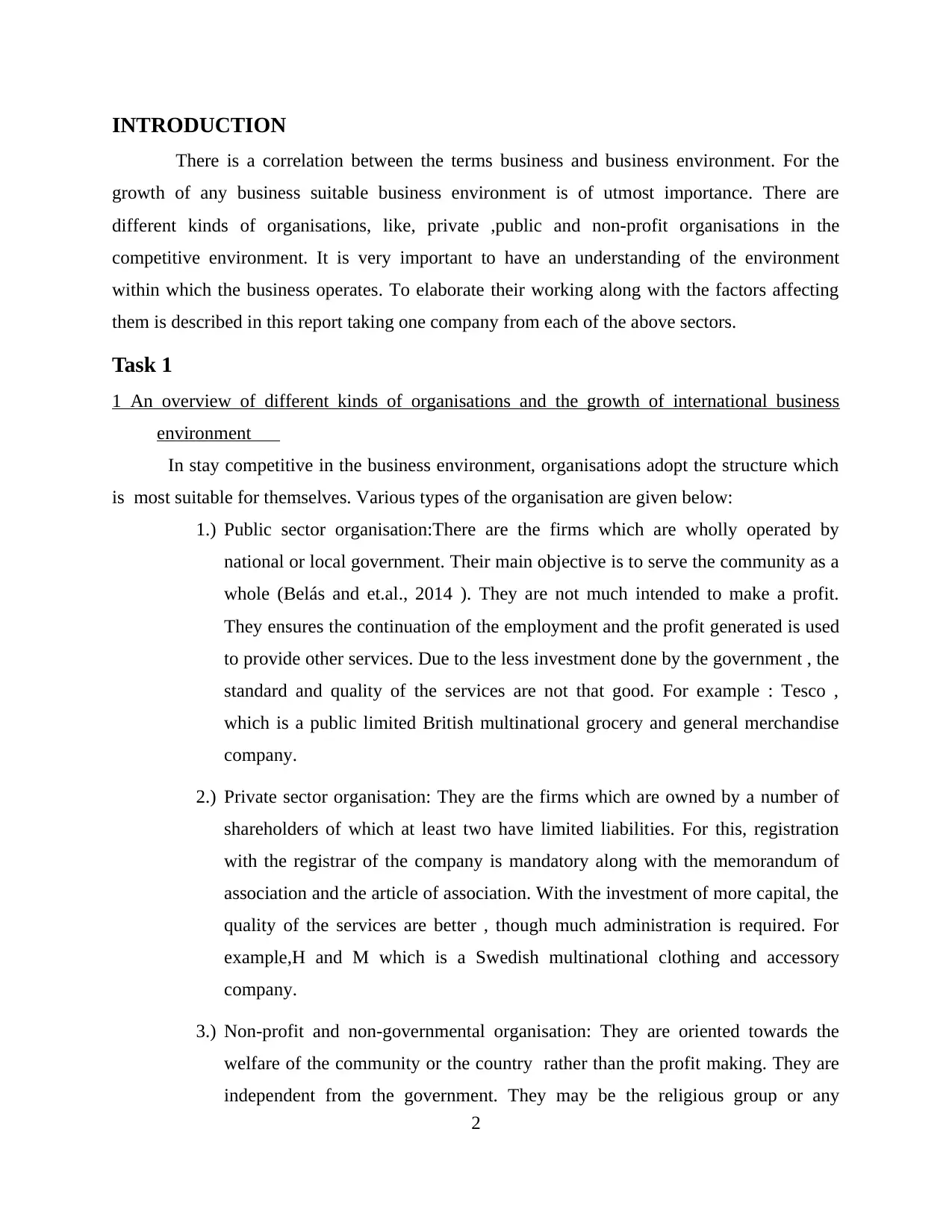
INTRODUCTION
There is a correlation between the terms business and business environment. For the
growth of any business suitable business environment is of utmost importance. There are
different kinds of organisations, like, private ,public and non-profit organisations in the
competitive environment. It is very important to have an understanding of the environment
within which the business operates. To elaborate their working along with the factors affecting
them is described in this report taking one company from each of the above sectors.
Task 1
1 An overview of different kinds of organisations and the growth of international business
environment
In stay competitive in the business environment, organisations adopt the structure which
is most suitable for themselves. Various types of the organisation are given below:
1.) Public sector organisation:There are the firms which are wholly operated by
national or local government. Their main objective is to serve the community as a
whole (Belás and et.al., 2014 ). They are not much intended to make a profit.
They ensures the continuation of the employment and the profit generated is used
to provide other services. Due to the less investment done by the government , the
standard and quality of the services are not that good. For example : Tesco ,
which is a public limited British multinational grocery and general merchandise
company.
2.) Private sector organisation: They are the firms which are owned by a number of
shareholders of which at least two have limited liabilities. For this, registration
with the registrar of the company is mandatory along with the memorandum of
association and the article of association. With the investment of more capital, the
quality of the services are better , though much administration is required. For
example,H and M which is a Swedish multinational clothing and accessory
company.
3.) Non-profit and non-governmental organisation: They are oriented towards the
welfare of the community or the country rather than the profit making. They are
independent from the government. They may be the religious group or any
2
There is a correlation between the terms business and business environment. For the
growth of any business suitable business environment is of utmost importance. There are
different kinds of organisations, like, private ,public and non-profit organisations in the
competitive environment. It is very important to have an understanding of the environment
within which the business operates. To elaborate their working along with the factors affecting
them is described in this report taking one company from each of the above sectors.
Task 1
1 An overview of different kinds of organisations and the growth of international business
environment
In stay competitive in the business environment, organisations adopt the structure which
is most suitable for themselves. Various types of the organisation are given below:
1.) Public sector organisation:There are the firms which are wholly operated by
national or local government. Their main objective is to serve the community as a
whole (Belás and et.al., 2014 ). They are not much intended to make a profit.
They ensures the continuation of the employment and the profit generated is used
to provide other services. Due to the less investment done by the government , the
standard and quality of the services are not that good. For example : Tesco ,
which is a public limited British multinational grocery and general merchandise
company.
2.) Private sector organisation: They are the firms which are owned by a number of
shareholders of which at least two have limited liabilities. For this, registration
with the registrar of the company is mandatory along with the memorandum of
association and the article of association. With the investment of more capital, the
quality of the services are better , though much administration is required. For
example,H and M which is a Swedish multinational clothing and accessory
company.
3.) Non-profit and non-governmental organisation: They are oriented towards the
welfare of the community or the country rather than the profit making. They are
independent from the government. They may be the religious group or any
2
⊘ This is a preview!⊘
Do you want full access?
Subscribe today to unlock all pages.

Trusted by 1+ million students worldwide
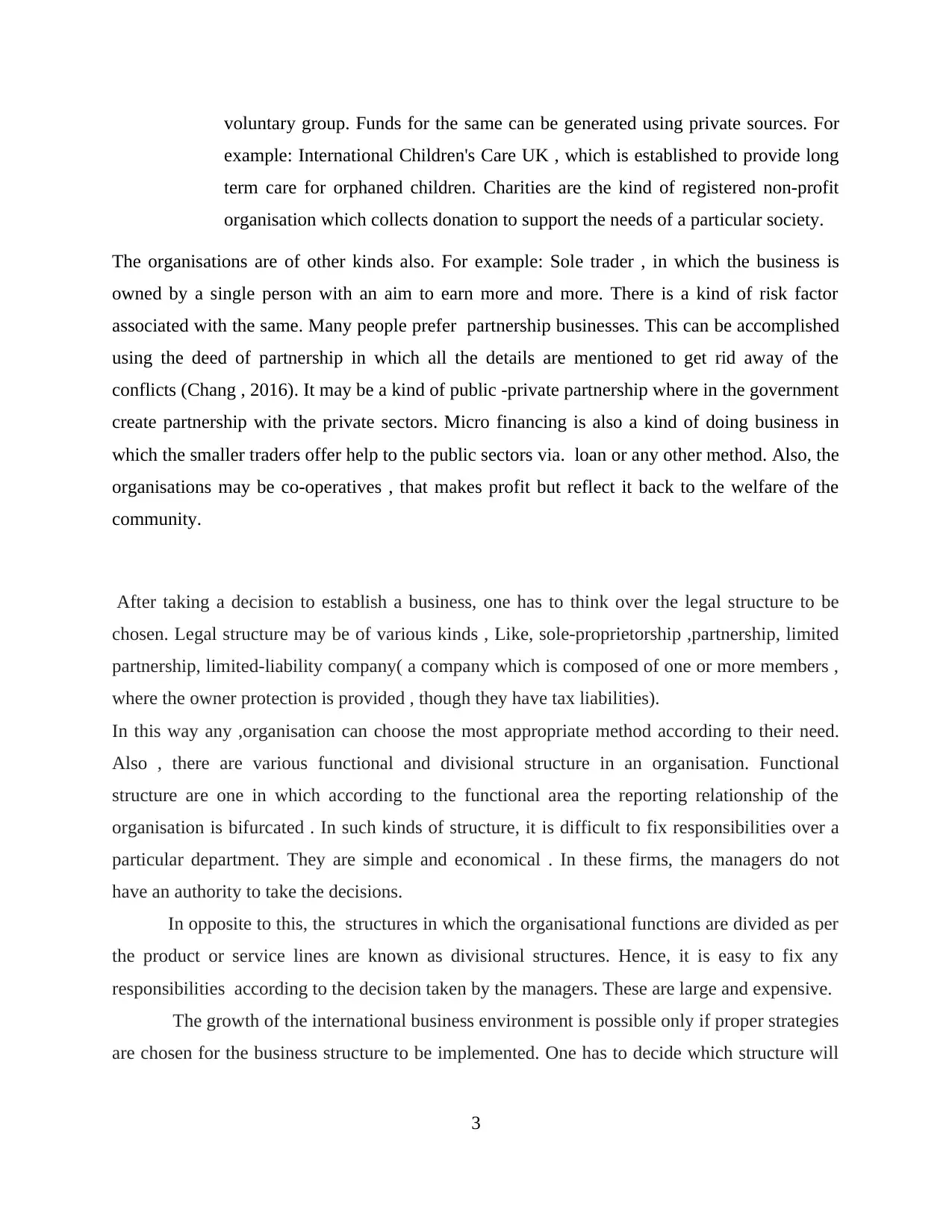
voluntary group. Funds for the same can be generated using private sources. For
example: International Children's Care UK , which is established to provide long
term care for orphaned children. Charities are the kind of registered non-profit
organisation which collects donation to support the needs of a particular society.
The organisations are of other kinds also. For example: Sole trader , in which the business is
owned by a single person with an aim to earn more and more. There is a kind of risk factor
associated with the same. Many people prefer partnership businesses. This can be accomplished
using the deed of partnership in which all the details are mentioned to get rid away of the
conflicts (Chang , 2016). It may be a kind of public -private partnership where in the government
create partnership with the private sectors. Micro financing is also a kind of doing business in
which the smaller traders offer help to the public sectors via. loan or any other method. Also, the
organisations may be co-operatives , that makes profit but reflect it back to the welfare of the
community.
After taking a decision to establish a business, one has to think over the legal structure to be
chosen. Legal structure may be of various kinds , Like, sole-proprietorship ,partnership, limited
partnership, limited-liability company( a company which is composed of one or more members ,
where the owner protection is provided , though they have tax liabilities).
In this way any ,organisation can choose the most appropriate method according to their need.
Also , there are various functional and divisional structure in an organisation. Functional
structure are one in which according to the functional area the reporting relationship of the
organisation is bifurcated . In such kinds of structure, it is difficult to fix responsibilities over a
particular department. They are simple and economical . In these firms, the managers do not
have an authority to take the decisions.
In opposite to this, the structures in which the organisational functions are divided as per
the product or service lines are known as divisional structures. Hence, it is easy to fix any
responsibilities according to the decision taken by the managers. These are large and expensive.
The growth of the international business environment is possible only if proper strategies
are chosen for the business structure to be implemented. One has to decide which structure will
3
example: International Children's Care UK , which is established to provide long
term care for orphaned children. Charities are the kind of registered non-profit
organisation which collects donation to support the needs of a particular society.
The organisations are of other kinds also. For example: Sole trader , in which the business is
owned by a single person with an aim to earn more and more. There is a kind of risk factor
associated with the same. Many people prefer partnership businesses. This can be accomplished
using the deed of partnership in which all the details are mentioned to get rid away of the
conflicts (Chang , 2016). It may be a kind of public -private partnership where in the government
create partnership with the private sectors. Micro financing is also a kind of doing business in
which the smaller traders offer help to the public sectors via. loan or any other method. Also, the
organisations may be co-operatives , that makes profit but reflect it back to the welfare of the
community.
After taking a decision to establish a business, one has to think over the legal structure to be
chosen. Legal structure may be of various kinds , Like, sole-proprietorship ,partnership, limited
partnership, limited-liability company( a company which is composed of one or more members ,
where the owner protection is provided , though they have tax liabilities).
In this way any ,organisation can choose the most appropriate method according to their need.
Also , there are various functional and divisional structure in an organisation. Functional
structure are one in which according to the functional area the reporting relationship of the
organisation is bifurcated . In such kinds of structure, it is difficult to fix responsibilities over a
particular department. They are simple and economical . In these firms, the managers do not
have an authority to take the decisions.
In opposite to this, the structures in which the organisational functions are divided as per
the product or service lines are known as divisional structures. Hence, it is easy to fix any
responsibilities according to the decision taken by the managers. These are large and expensive.
The growth of the international business environment is possible only if proper strategies
are chosen for the business structure to be implemented. One has to decide which structure will
3
Paraphrase This Document
Need a fresh take? Get an instant paraphrase of this document with our AI Paraphraser
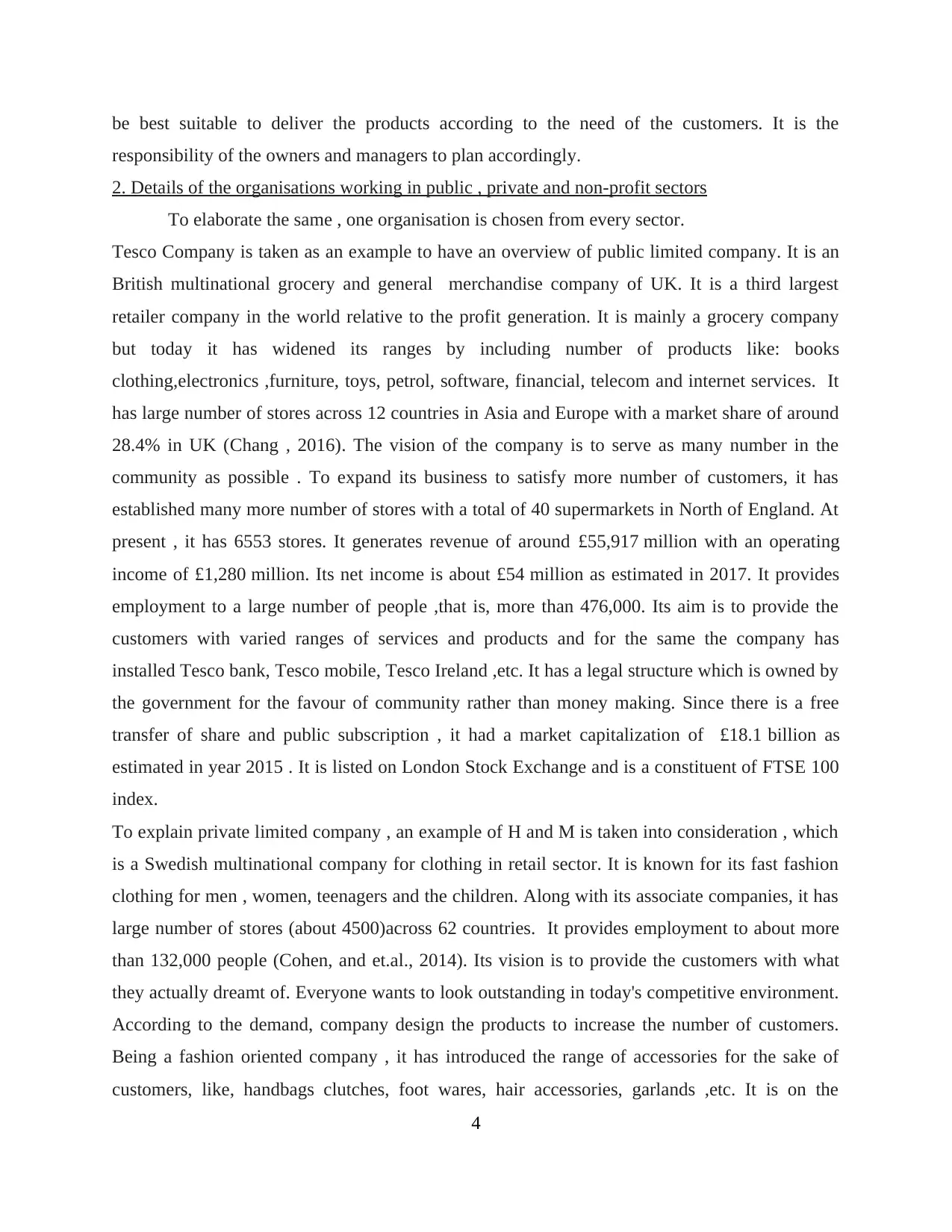
be best suitable to deliver the products according to the need of the customers. It is the
responsibility of the owners and managers to plan accordingly.
2. Details of the organisations working in public , private and non-profit sectors
To elaborate the same , one organisation is chosen from every sector.
Tesco Company is taken as an example to have an overview of public limited company. It is an
British multinational grocery and general merchandise company of UK. It is a third largest
retailer company in the world relative to the profit generation. It is mainly a grocery company
but today it has widened its ranges by including number of products like: books
clothing,electronics ,furniture, toys, petrol, software, financial, telecom and internet services. It
has large number of stores across 12 countries in Asia and Europe with a market share of around
28.4% in UK (Chang , 2016). The vision of the company is to serve as many number in the
community as possible . To expand its business to satisfy more number of customers, it has
established many more number of stores with a total of 40 supermarkets in North of England. At
present , it has 6553 stores. It generates revenue of around £55,917 million with an operating
income of £1,280 million. Its net income is about £54 million as estimated in 2017. It provides
employment to a large number of people ,that is, more than 476,000. Its aim is to provide the
customers with varied ranges of services and products and for the same the company has
installed Tesco bank, Tesco mobile, Tesco Ireland ,etc. It has a legal structure which is owned by
the government for the favour of community rather than money making. Since there is a free
transfer of share and public subscription , it had a market capitalization of £18.1 billion as
estimated in year 2015 . It is listed on London Stock Exchange and is a constituent of FTSE 100
index.
To explain private limited company , an example of H and M is taken into consideration , which
is a Swedish multinational company for clothing in retail sector. It is known for its fast fashion
clothing for men , women, teenagers and the children. Along with its associate companies, it has
large number of stores (about 4500)across 62 countries. It provides employment to about more
than 132,000 people (Cohen, and et.al., 2014). Its vision is to provide the customers with what
they actually dreamt of. Everyone wants to look outstanding in today's competitive environment.
According to the demand, company design the products to increase the number of customers.
Being a fashion oriented company , it has introduced the range of accessories for the sake of
customers, like, handbags clutches, foot wares, hair accessories, garlands ,etc. It is on the
4
responsibility of the owners and managers to plan accordingly.
2. Details of the organisations working in public , private and non-profit sectors
To elaborate the same , one organisation is chosen from every sector.
Tesco Company is taken as an example to have an overview of public limited company. It is an
British multinational grocery and general merchandise company of UK. It is a third largest
retailer company in the world relative to the profit generation. It is mainly a grocery company
but today it has widened its ranges by including number of products like: books
clothing,electronics ,furniture, toys, petrol, software, financial, telecom and internet services. It
has large number of stores across 12 countries in Asia and Europe with a market share of around
28.4% in UK (Chang , 2016). The vision of the company is to serve as many number in the
community as possible . To expand its business to satisfy more number of customers, it has
established many more number of stores with a total of 40 supermarkets in North of England. At
present , it has 6553 stores. It generates revenue of around £55,917 million with an operating
income of £1,280 million. Its net income is about £54 million as estimated in 2017. It provides
employment to a large number of people ,that is, more than 476,000. Its aim is to provide the
customers with varied ranges of services and products and for the same the company has
installed Tesco bank, Tesco mobile, Tesco Ireland ,etc. It has a legal structure which is owned by
the government for the favour of community rather than money making. Since there is a free
transfer of share and public subscription , it had a market capitalization of £18.1 billion as
estimated in year 2015 . It is listed on London Stock Exchange and is a constituent of FTSE 100
index.
To explain private limited company , an example of H and M is taken into consideration , which
is a Swedish multinational company for clothing in retail sector. It is known for its fast fashion
clothing for men , women, teenagers and the children. Along with its associate companies, it has
large number of stores (about 4500)across 62 countries. It provides employment to about more
than 132,000 people (Cohen, and et.al., 2014). Its vision is to provide the customers with what
they actually dreamt of. Everyone wants to look outstanding in today's competitive environment.
According to the demand, company design the products to increase the number of customers.
Being a fashion oriented company , it has introduced the range of accessories for the sake of
customers, like, handbags clutches, foot wares, hair accessories, garlands ,etc. It is on the
4
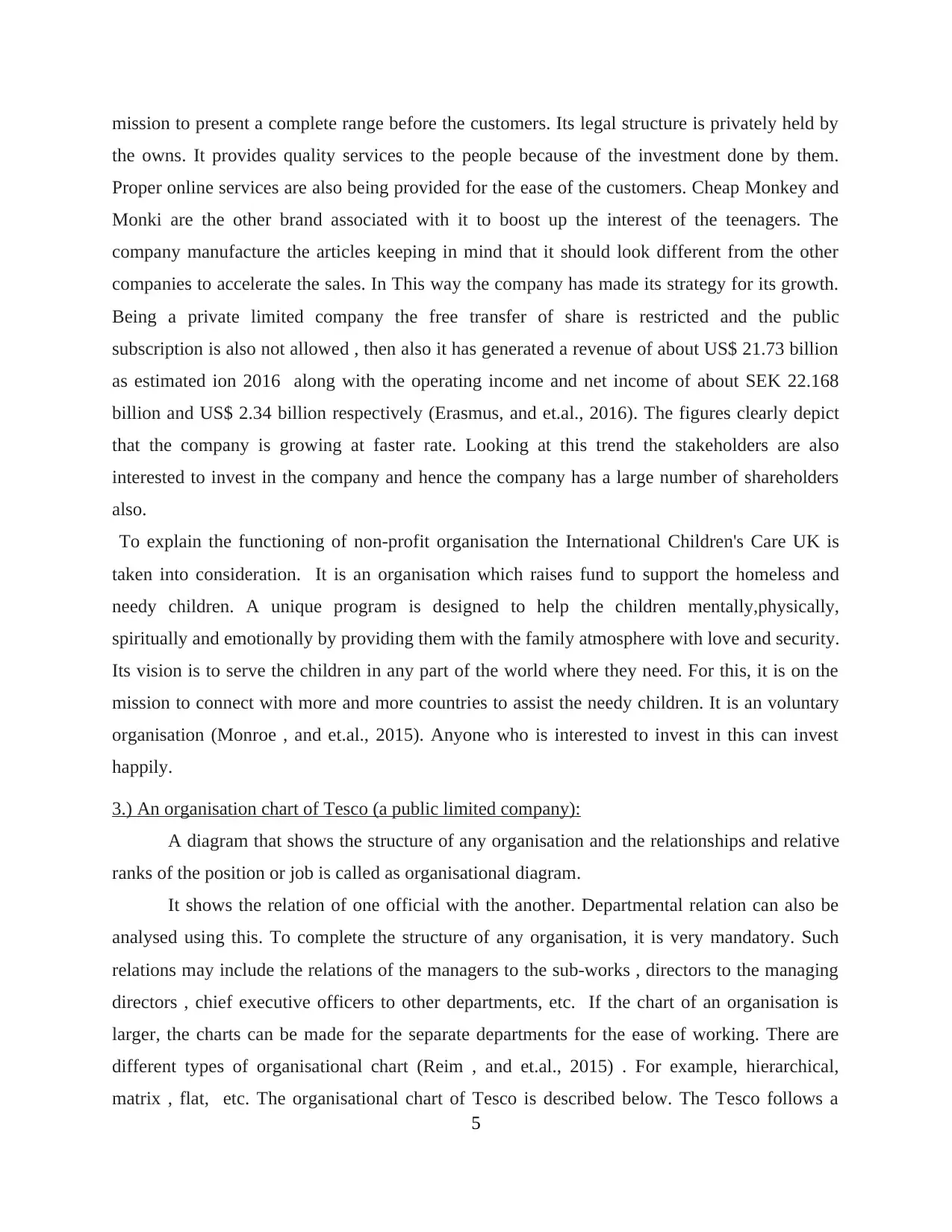
mission to present a complete range before the customers. Its legal structure is privately held by
the owns. It provides quality services to the people because of the investment done by them.
Proper online services are also being provided for the ease of the customers. Cheap Monkey and
Monki are the other brand associated with it to boost up the interest of the teenagers. The
company manufacture the articles keeping in mind that it should look different from the other
companies to accelerate the sales. In This way the company has made its strategy for its growth.
Being a private limited company the free transfer of share is restricted and the public
subscription is also not allowed , then also it has generated a revenue of about US$ 21.73 billion
as estimated ion 2016 along with the operating income and net income of about SEK 22.168
billion and US$ 2.34 billion respectively (Erasmus, and et.al., 2016). The figures clearly depict
that the company is growing at faster rate. Looking at this trend the stakeholders are also
interested to invest in the company and hence the company has a large number of shareholders
also.
To explain the functioning of non-profit organisation the International Children's Care UK is
taken into consideration. It is an organisation which raises fund to support the homeless and
needy children. A unique program is designed to help the children mentally,physically,
spiritually and emotionally by providing them with the family atmosphere with love and security.
Its vision is to serve the children in any part of the world where they need. For this, it is on the
mission to connect with more and more countries to assist the needy children. It is an voluntary
organisation (Monroe , and et.al., 2015). Anyone who is interested to invest in this can invest
happily.
3.) An organisation chart of Tesco (a public limited company):
A diagram that shows the structure of any organisation and the relationships and relative
ranks of the position or job is called as organisational diagram.
It shows the relation of one official with the another. Departmental relation can also be
analysed using this. To complete the structure of any organisation, it is very mandatory. Such
relations may include the relations of the managers to the sub-works , directors to the managing
directors , chief executive officers to other departments, etc. If the chart of an organisation is
larger, the charts can be made for the separate departments for the ease of working. There are
different types of organisational chart (Reim , and et.al., 2015) . For example, hierarchical,
matrix , flat, etc. The organisational chart of Tesco is described below. The Tesco follows a
5
the owns. It provides quality services to the people because of the investment done by them.
Proper online services are also being provided for the ease of the customers. Cheap Monkey and
Monki are the other brand associated with it to boost up the interest of the teenagers. The
company manufacture the articles keeping in mind that it should look different from the other
companies to accelerate the sales. In This way the company has made its strategy for its growth.
Being a private limited company the free transfer of share is restricted and the public
subscription is also not allowed , then also it has generated a revenue of about US$ 21.73 billion
as estimated ion 2016 along with the operating income and net income of about SEK 22.168
billion and US$ 2.34 billion respectively (Erasmus, and et.al., 2016). The figures clearly depict
that the company is growing at faster rate. Looking at this trend the stakeholders are also
interested to invest in the company and hence the company has a large number of shareholders
also.
To explain the functioning of non-profit organisation the International Children's Care UK is
taken into consideration. It is an organisation which raises fund to support the homeless and
needy children. A unique program is designed to help the children mentally,physically,
spiritually and emotionally by providing them with the family atmosphere with love and security.
Its vision is to serve the children in any part of the world where they need. For this, it is on the
mission to connect with more and more countries to assist the needy children. It is an voluntary
organisation (Monroe , and et.al., 2015). Anyone who is interested to invest in this can invest
happily.
3.) An organisation chart of Tesco (a public limited company):
A diagram that shows the structure of any organisation and the relationships and relative
ranks of the position or job is called as organisational diagram.
It shows the relation of one official with the another. Departmental relation can also be
analysed using this. To complete the structure of any organisation, it is very mandatory. Such
relations may include the relations of the managers to the sub-works , directors to the managing
directors , chief executive officers to other departments, etc. If the chart of an organisation is
larger, the charts can be made for the separate departments for the ease of working. There are
different types of organisational chart (Reim , and et.al., 2015) . For example, hierarchical,
matrix , flat, etc. The organisational chart of Tesco is described below. The Tesco follows a
5
⊘ This is a preview!⊘
Do you want full access?
Subscribe today to unlock all pages.

Trusted by 1+ million students worldwide
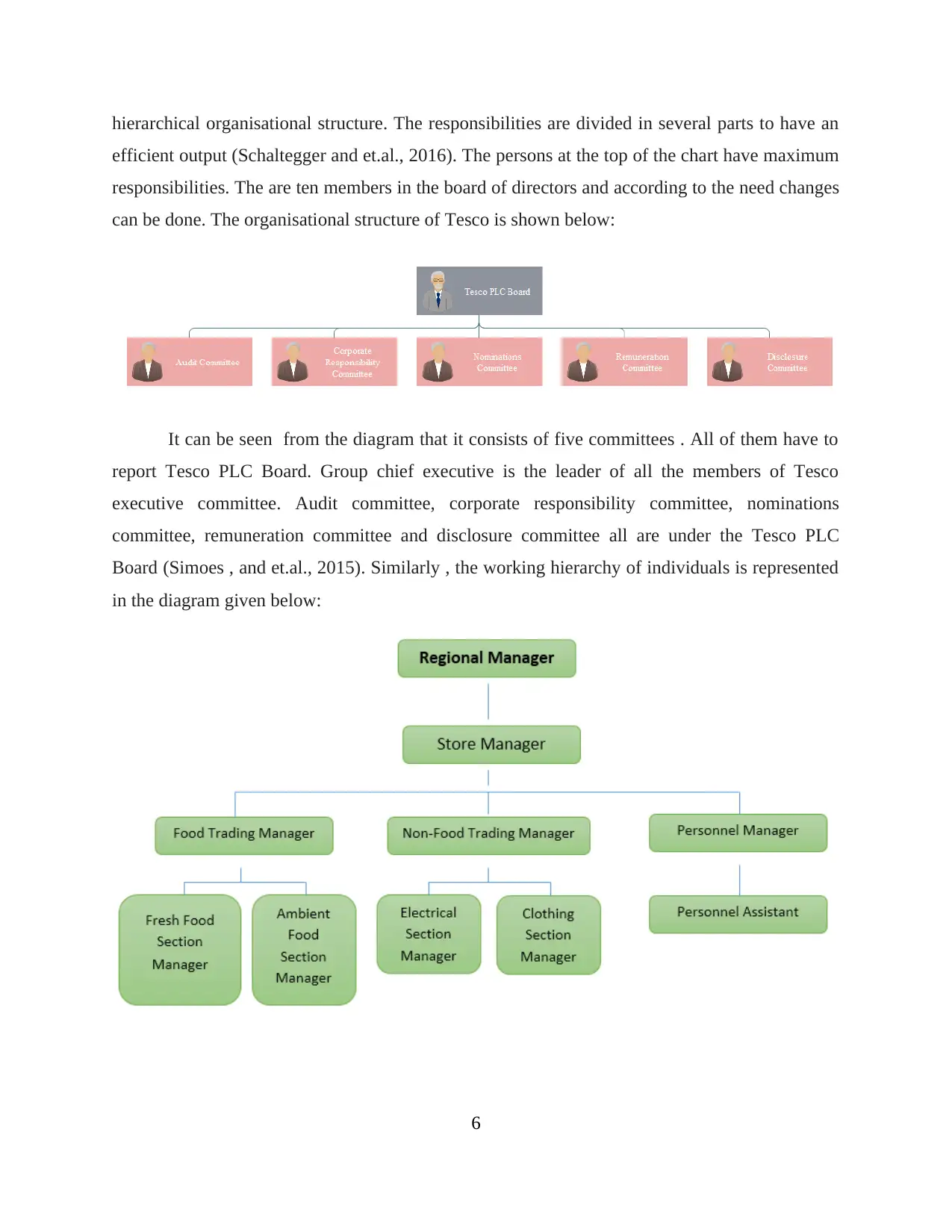
hierarchical organisational structure. The responsibilities are divided in several parts to have an
efficient output (Schaltegger and et.al., 2016). The persons at the top of the chart have maximum
responsibilities. The are ten members in the board of directors and according to the need changes
can be done. The organisational structure of Tesco is shown below:
It can be seen from the diagram that it consists of five committees . All of them have to
report Tesco PLC Board. Group chief executive is the leader of all the members of Tesco
executive committee. Audit committee, corporate responsibility committee, nominations
committee, remuneration committee and disclosure committee all are under the Tesco PLC
Board (Simoes , and et.al., 2015). Similarly , the working hierarchy of individuals is represented
in the diagram given below:
6
efficient output (Schaltegger and et.al., 2016). The persons at the top of the chart have maximum
responsibilities. The are ten members in the board of directors and according to the need changes
can be done. The organisational structure of Tesco is shown below:
It can be seen from the diagram that it consists of five committees . All of them have to
report Tesco PLC Board. Group chief executive is the leader of all the members of Tesco
executive committee. Audit committee, corporate responsibility committee, nominations
committee, remuneration committee and disclosure committee all are under the Tesco PLC
Board (Simoes , and et.al., 2015). Similarly , the working hierarchy of individuals is represented
in the diagram given below:
6
Paraphrase This Document
Need a fresh take? Get an instant paraphrase of this document with our AI Paraphraser
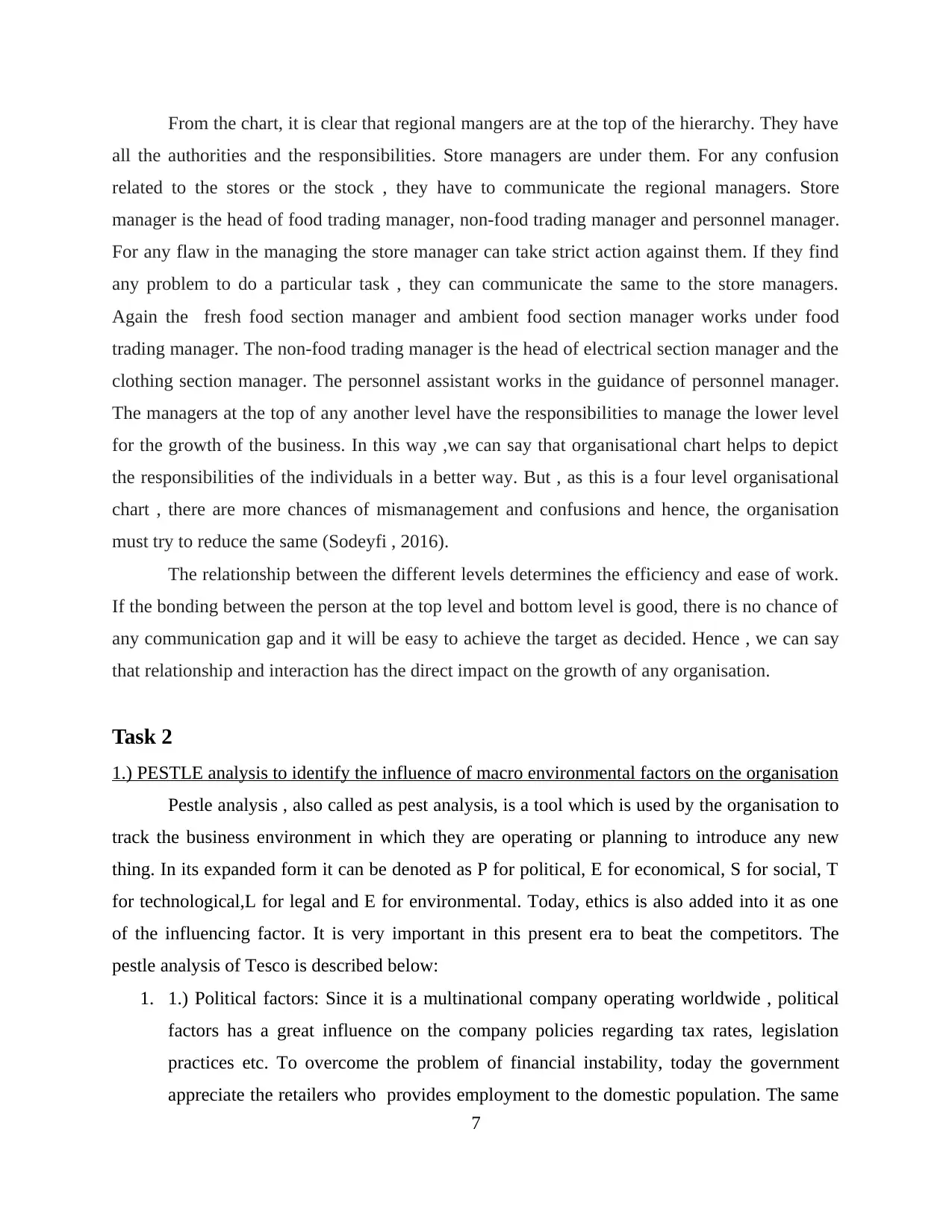
From the chart, it is clear that regional mangers are at the top of the hierarchy. They have
all the authorities and the responsibilities. Store managers are under them. For any confusion
related to the stores or the stock , they have to communicate the regional managers. Store
manager is the head of food trading manager, non-food trading manager and personnel manager.
For any flaw in the managing the store manager can take strict action against them. If they find
any problem to do a particular task , they can communicate the same to the store managers.
Again the fresh food section manager and ambient food section manager works under food
trading manager. The non-food trading manager is the head of electrical section manager and the
clothing section manager. The personnel assistant works in the guidance of personnel manager.
The managers at the top of any another level have the responsibilities to manage the lower level
for the growth of the business. In this way ,we can say that organisational chart helps to depict
the responsibilities of the individuals in a better way. But , as this is a four level organisational
chart , there are more chances of mismanagement and confusions and hence, the organisation
must try to reduce the same (Sodeyfi , 2016).
The relationship between the different levels determines the efficiency and ease of work.
If the bonding between the person at the top level and bottom level is good, there is no chance of
any communication gap and it will be easy to achieve the target as decided. Hence , we can say
that relationship and interaction has the direct impact on the growth of any organisation.
Task 2
1.) PESTLE analysis to identify the influence of macro environmental factors on the organisation
Pestle analysis , also called as pest analysis, is a tool which is used by the organisation to
track the business environment in which they are operating or planning to introduce any new
thing. In its expanded form it can be denoted as P for political, E for economical, S for social, T
for technological,L for legal and E for environmental. Today, ethics is also added into it as one
of the influencing factor. It is very important in this present era to beat the competitors. The
pestle analysis of Tesco is described below:
1. 1.) Political factors: Since it is a multinational company operating worldwide , political
factors has a great influence on the company policies regarding tax rates, legislation
practices etc. To overcome the problem of financial instability, today the government
appreciate the retailers who provides employment to the domestic population. The same
7
all the authorities and the responsibilities. Store managers are under them. For any confusion
related to the stores or the stock , they have to communicate the regional managers. Store
manager is the head of food trading manager, non-food trading manager and personnel manager.
For any flaw in the managing the store manager can take strict action against them. If they find
any problem to do a particular task , they can communicate the same to the store managers.
Again the fresh food section manager and ambient food section manager works under food
trading manager. The non-food trading manager is the head of electrical section manager and the
clothing section manager. The personnel assistant works in the guidance of personnel manager.
The managers at the top of any another level have the responsibilities to manage the lower level
for the growth of the business. In this way ,we can say that organisational chart helps to depict
the responsibilities of the individuals in a better way. But , as this is a four level organisational
chart , there are more chances of mismanagement and confusions and hence, the organisation
must try to reduce the same (Sodeyfi , 2016).
The relationship between the different levels determines the efficiency and ease of work.
If the bonding between the person at the top level and bottom level is good, there is no chance of
any communication gap and it will be easy to achieve the target as decided. Hence , we can say
that relationship and interaction has the direct impact on the growth of any organisation.
Task 2
1.) PESTLE analysis to identify the influence of macro environmental factors on the organisation
Pestle analysis , also called as pest analysis, is a tool which is used by the organisation to
track the business environment in which they are operating or planning to introduce any new
thing. In its expanded form it can be denoted as P for political, E for economical, S for social, T
for technological,L for legal and E for environmental. Today, ethics is also added into it as one
of the influencing factor. It is very important in this present era to beat the competitors. The
pestle analysis of Tesco is described below:
1. 1.) Political factors: Since it is a multinational company operating worldwide , political
factors has a great influence on the company policies regarding tax rates, legislation
practices etc. To overcome the problem of financial instability, today the government
appreciate the retailers who provides employment to the domestic population. The same
7
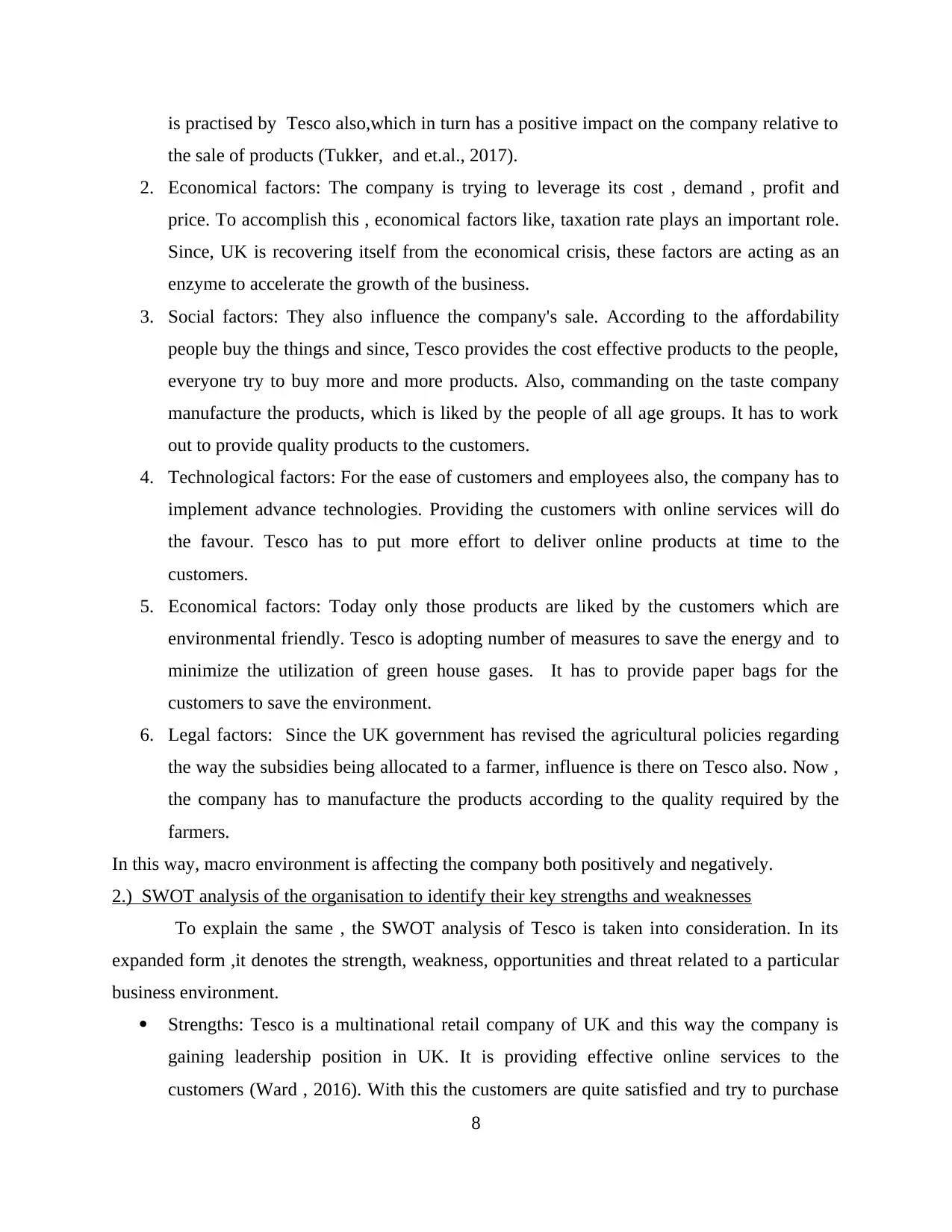
is practised by Tesco also,which in turn has a positive impact on the company relative to
the sale of products (Tukker, and et.al., 2017).
2. Economical factors: The company is trying to leverage its cost , demand , profit and
price. To accomplish this , economical factors like, taxation rate plays an important role.
Since, UK is recovering itself from the economical crisis, these factors are acting as an
enzyme to accelerate the growth of the business.
3. Social factors: They also influence the company's sale. According to the affordability
people buy the things and since, Tesco provides the cost effective products to the people,
everyone try to buy more and more products. Also, commanding on the taste company
manufacture the products, which is liked by the people of all age groups. It has to work
out to provide quality products to the customers.
4. Technological factors: For the ease of customers and employees also, the company has to
implement advance technologies. Providing the customers with online services will do
the favour. Tesco has to put more effort to deliver online products at time to the
customers.
5. Economical factors: Today only those products are liked by the customers which are
environmental friendly. Tesco is adopting number of measures to save the energy and to
minimize the utilization of green house gases. It has to provide paper bags for the
customers to save the environment.
6. Legal factors: Since the UK government has revised the agricultural policies regarding
the way the subsidies being allocated to a farmer, influence is there on Tesco also. Now ,
the company has to manufacture the products according to the quality required by the
farmers.
In this way, macro environment is affecting the company both positively and negatively.
2.) SWOT analysis of the organisation to identify their key strengths and weaknesses
To explain the same , the SWOT analysis of Tesco is taken into consideration. In its
expanded form ,it denotes the strength, weakness, opportunities and threat related to a particular
business environment.
Strengths: Tesco is a multinational retail company of UK and this way the company is
gaining leadership position in UK. It is providing effective online services to the
customers (Ward , 2016). With this the customers are quite satisfied and try to purchase
8
the sale of products (Tukker, and et.al., 2017).
2. Economical factors: The company is trying to leverage its cost , demand , profit and
price. To accomplish this , economical factors like, taxation rate plays an important role.
Since, UK is recovering itself from the economical crisis, these factors are acting as an
enzyme to accelerate the growth of the business.
3. Social factors: They also influence the company's sale. According to the affordability
people buy the things and since, Tesco provides the cost effective products to the people,
everyone try to buy more and more products. Also, commanding on the taste company
manufacture the products, which is liked by the people of all age groups. It has to work
out to provide quality products to the customers.
4. Technological factors: For the ease of customers and employees also, the company has to
implement advance technologies. Providing the customers with online services will do
the favour. Tesco has to put more effort to deliver online products at time to the
customers.
5. Economical factors: Today only those products are liked by the customers which are
environmental friendly. Tesco is adopting number of measures to save the energy and to
minimize the utilization of green house gases. It has to provide paper bags for the
customers to save the environment.
6. Legal factors: Since the UK government has revised the agricultural policies regarding
the way the subsidies being allocated to a farmer, influence is there on Tesco also. Now ,
the company has to manufacture the products according to the quality required by the
farmers.
In this way, macro environment is affecting the company both positively and negatively.
2.) SWOT analysis of the organisation to identify their key strengths and weaknesses
To explain the same , the SWOT analysis of Tesco is taken into consideration. In its
expanded form ,it denotes the strength, weakness, opportunities and threat related to a particular
business environment.
Strengths: Tesco is a multinational retail company of UK and this way the company is
gaining leadership position in UK. It is providing effective online services to the
customers (Ward , 2016). With this the customers are quite satisfied and try to purchase
8
⊘ This is a preview!⊘
Do you want full access?
Subscribe today to unlock all pages.

Trusted by 1+ million students worldwide
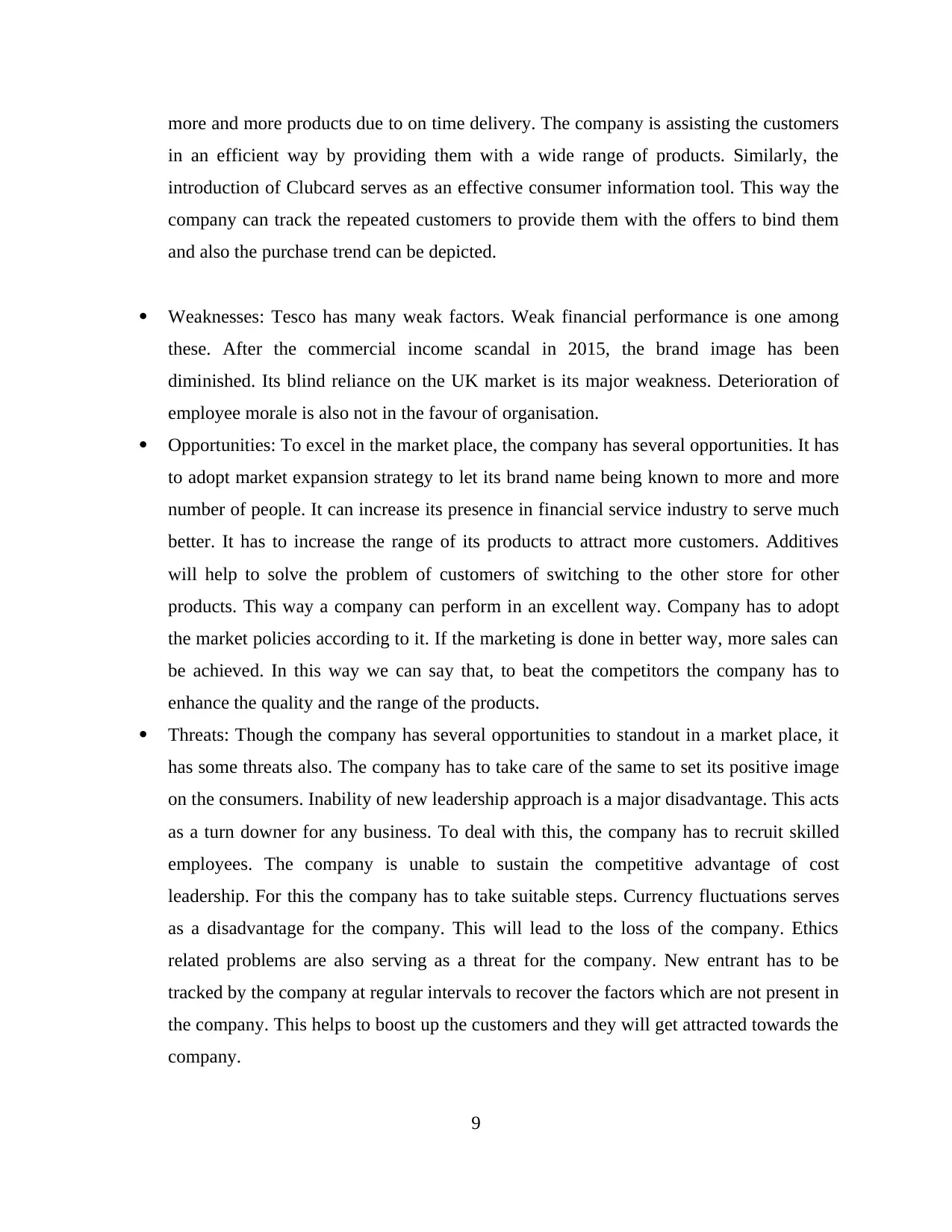
more and more products due to on time delivery. The company is assisting the customers
in an efficient way by providing them with a wide range of products. Similarly, the
introduction of Clubcard serves as an effective consumer information tool. This way the
company can track the repeated customers to provide them with the offers to bind them
and also the purchase trend can be depicted.
Weaknesses: Tesco has many weak factors. Weak financial performance is one among
these. After the commercial income scandal in 2015, the brand image has been
diminished. Its blind reliance on the UK market is its major weakness. Deterioration of
employee morale is also not in the favour of organisation.
Opportunities: To excel in the market place, the company has several opportunities. It has
to adopt market expansion strategy to let its brand name being known to more and more
number of people. It can increase its presence in financial service industry to serve much
better. It has to increase the range of its products to attract more customers. Additives
will help to solve the problem of customers of switching to the other store for other
products. This way a company can perform in an excellent way. Company has to adopt
the market policies according to it. If the marketing is done in better way, more sales can
be achieved. In this way we can say that, to beat the competitors the company has to
enhance the quality and the range of the products.
Threats: Though the company has several opportunities to standout in a market place, it
has some threats also. The company has to take care of the same to set its positive image
on the consumers. Inability of new leadership approach is a major disadvantage. This acts
as a turn downer for any business. To deal with this, the company has to recruit skilled
employees. The company is unable to sustain the competitive advantage of cost
leadership. For this the company has to take suitable steps. Currency fluctuations serves
as a disadvantage for the company. This will lead to the loss of the company. Ethics
related problems are also serving as a threat for the company. New entrant has to be
tracked by the company at regular intervals to recover the factors which are not present in
the company. This helps to boost up the customers and they will get attracted towards the
company.
9
in an efficient way by providing them with a wide range of products. Similarly, the
introduction of Clubcard serves as an effective consumer information tool. This way the
company can track the repeated customers to provide them with the offers to bind them
and also the purchase trend can be depicted.
Weaknesses: Tesco has many weak factors. Weak financial performance is one among
these. After the commercial income scandal in 2015, the brand image has been
diminished. Its blind reliance on the UK market is its major weakness. Deterioration of
employee morale is also not in the favour of organisation.
Opportunities: To excel in the market place, the company has several opportunities. It has
to adopt market expansion strategy to let its brand name being known to more and more
number of people. It can increase its presence in financial service industry to serve much
better. It has to increase the range of its products to attract more customers. Additives
will help to solve the problem of customers of switching to the other store for other
products. This way a company can perform in an excellent way. Company has to adopt
the market policies according to it. If the marketing is done in better way, more sales can
be achieved. In this way we can say that, to beat the competitors the company has to
enhance the quality and the range of the products.
Threats: Though the company has several opportunities to standout in a market place, it
has some threats also. The company has to take care of the same to set its positive image
on the consumers. Inability of new leadership approach is a major disadvantage. This acts
as a turn downer for any business. To deal with this, the company has to recruit skilled
employees. The company is unable to sustain the competitive advantage of cost
leadership. For this the company has to take suitable steps. Currency fluctuations serves
as a disadvantage for the company. This will lead to the loss of the company. Ethics
related problems are also serving as a threat for the company. New entrant has to be
tracked by the company at regular intervals to recover the factors which are not present in
the company. This helps to boost up the customers and they will get attracted towards the
company.
9
Paraphrase This Document
Need a fresh take? Get an instant paraphrase of this document with our AI Paraphraser
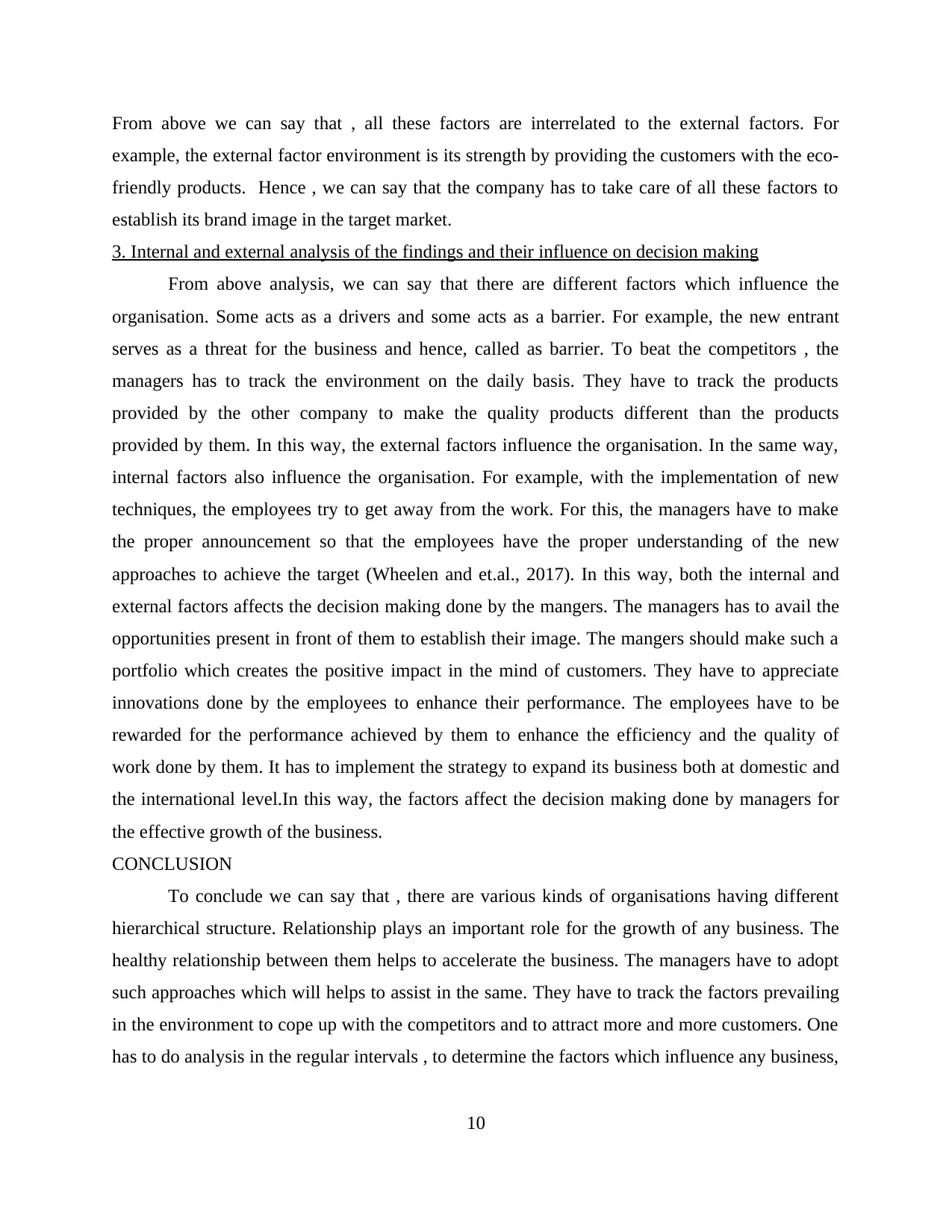
From above we can say that , all these factors are interrelated to the external factors. For
example, the external factor environment is its strength by providing the customers with the eco-
friendly products. Hence , we can say that the company has to take care of all these factors to
establish its brand image in the target market.
3. Internal and external analysis of the findings and their influence on decision making
From above analysis, we can say that there are different factors which influence the
organisation. Some acts as a drivers and some acts as a barrier. For example, the new entrant
serves as a threat for the business and hence, called as barrier. To beat the competitors , the
managers has to track the environment on the daily basis. They have to track the products
provided by the other company to make the quality products different than the products
provided by them. In this way, the external factors influence the organisation. In the same way,
internal factors also influence the organisation. For example, with the implementation of new
techniques, the employees try to get away from the work. For this, the managers have to make
the proper announcement so that the employees have the proper understanding of the new
approaches to achieve the target (Wheelen and et.al., 2017). In this way, both the internal and
external factors affects the decision making done by the mangers. The managers has to avail the
opportunities present in front of them to establish their image. The mangers should make such a
portfolio which creates the positive impact in the mind of customers. They have to appreciate
innovations done by the employees to enhance their performance. The employees have to be
rewarded for the performance achieved by them to enhance the efficiency and the quality of
work done by them. It has to implement the strategy to expand its business both at domestic and
the international level.In this way, the factors affect the decision making done by managers for
the effective growth of the business.
CONCLUSION
To conclude we can say that , there are various kinds of organisations having different
hierarchical structure. Relationship plays an important role for the growth of any business. The
healthy relationship between them helps to accelerate the business. The managers have to adopt
such approaches which will helps to assist in the same. They have to track the factors prevailing
in the environment to cope up with the competitors and to attract more and more customers. One
has to do analysis in the regular intervals , to determine the factors which influence any business,
10
example, the external factor environment is its strength by providing the customers with the eco-
friendly products. Hence , we can say that the company has to take care of all these factors to
establish its brand image in the target market.
3. Internal and external analysis of the findings and their influence on decision making
From above analysis, we can say that there are different factors which influence the
organisation. Some acts as a drivers and some acts as a barrier. For example, the new entrant
serves as a threat for the business and hence, called as barrier. To beat the competitors , the
managers has to track the environment on the daily basis. They have to track the products
provided by the other company to make the quality products different than the products
provided by them. In this way, the external factors influence the organisation. In the same way,
internal factors also influence the organisation. For example, with the implementation of new
techniques, the employees try to get away from the work. For this, the managers have to make
the proper announcement so that the employees have the proper understanding of the new
approaches to achieve the target (Wheelen and et.al., 2017). In this way, both the internal and
external factors affects the decision making done by the mangers. The managers has to avail the
opportunities present in front of them to establish their image. The mangers should make such a
portfolio which creates the positive impact in the mind of customers. They have to appreciate
innovations done by the employees to enhance their performance. The employees have to be
rewarded for the performance achieved by them to enhance the efficiency and the quality of
work done by them. It has to implement the strategy to expand its business both at domestic and
the international level.In this way, the factors affect the decision making done by managers for
the effective growth of the business.
CONCLUSION
To conclude we can say that , there are various kinds of organisations having different
hierarchical structure. Relationship plays an important role for the growth of any business. The
healthy relationship between them helps to accelerate the business. The managers have to adopt
such approaches which will helps to assist in the same. They have to track the factors prevailing
in the environment to cope up with the competitors and to attract more and more customers. One
has to do analysis in the regular intervals , to determine the factors which influence any business,
10
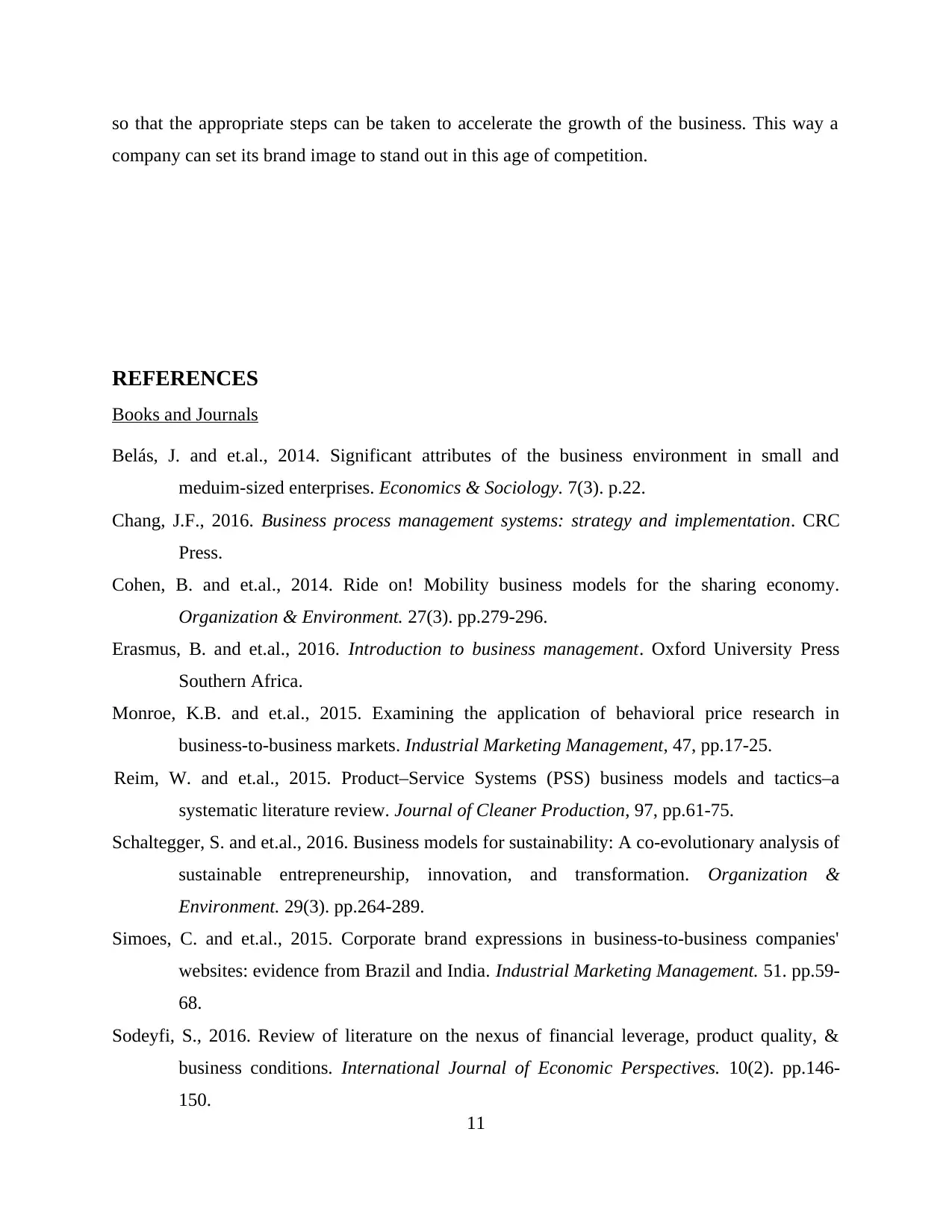
so that the appropriate steps can be taken to accelerate the growth of the business. This way a
company can set its brand image to stand out in this age of competition.
REFERENCES
Books and Journals
Belás, J. and et.al., 2014. Significant attributes of the business environment in small and
meduim-sized enterprises. Economics & Sociology. 7(3). p.22.
Chang, J.F., 2016. Business process management systems: strategy and implementation. CRC
Press.
Cohen, B. and et.al., 2014. Ride on! Mobility business models for the sharing economy.
Organization & Environment. 27(3). pp.279-296.
Erasmus, B. and et.al., 2016. Introduction to business management. Oxford University Press
Southern Africa.
Monroe, K.B. and et.al., 2015. Examining the application of behavioral price research in
business-to-business markets. Industrial Marketing Management, 47, pp.17-25.
Reim, W. and et.al., 2015. Product–Service Systems (PSS) business models and tactics–a
systematic literature review. Journal of Cleaner Production, 97, pp.61-75.
Schaltegger, S. and et.al., 2016. Business models for sustainability: A co-evolutionary analysis of
sustainable entrepreneurship, innovation, and transformation. Organization &
Environment. 29(3). pp.264-289.
Simoes, C. and et.al., 2015. Corporate brand expressions in business-to-business companies'
websites: evidence from Brazil and India. Industrial Marketing Management. 51. pp.59-
68.
Sodeyfi, S., 2016. Review of literature on the nexus of financial leverage, product quality, &
business conditions. International Journal of Economic Perspectives. 10(2). pp.146-
150.
11
company can set its brand image to stand out in this age of competition.
REFERENCES
Books and Journals
Belás, J. and et.al., 2014. Significant attributes of the business environment in small and
meduim-sized enterprises. Economics & Sociology. 7(3). p.22.
Chang, J.F., 2016. Business process management systems: strategy and implementation. CRC
Press.
Cohen, B. and et.al., 2014. Ride on! Mobility business models for the sharing economy.
Organization & Environment. 27(3). pp.279-296.
Erasmus, B. and et.al., 2016. Introduction to business management. Oxford University Press
Southern Africa.
Monroe, K.B. and et.al., 2015. Examining the application of behavioral price research in
business-to-business markets. Industrial Marketing Management, 47, pp.17-25.
Reim, W. and et.al., 2015. Product–Service Systems (PSS) business models and tactics–a
systematic literature review. Journal of Cleaner Production, 97, pp.61-75.
Schaltegger, S. and et.al., 2016. Business models for sustainability: A co-evolutionary analysis of
sustainable entrepreneurship, innovation, and transformation. Organization &
Environment. 29(3). pp.264-289.
Simoes, C. and et.al., 2015. Corporate brand expressions in business-to-business companies'
websites: evidence from Brazil and India. Industrial Marketing Management. 51. pp.59-
68.
Sodeyfi, S., 2016. Review of literature on the nexus of financial leverage, product quality, &
business conditions. International Journal of Economic Perspectives. 10(2). pp.146-
150.
11
⊘ This is a preview!⊘
Do you want full access?
Subscribe today to unlock all pages.

Trusted by 1+ million students worldwide
1 out of 13
Related Documents
Your All-in-One AI-Powered Toolkit for Academic Success.
+13062052269
info@desklib.com
Available 24*7 on WhatsApp / Email
![[object Object]](/_next/static/media/star-bottom.7253800d.svg)
Unlock your academic potential
Copyright © 2020–2025 A2Z Services. All Rights Reserved. Developed and managed by ZUCOL.





